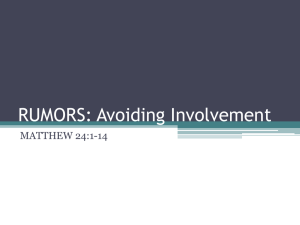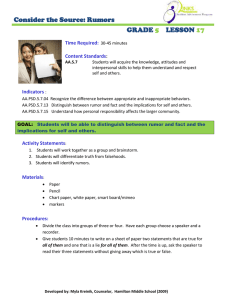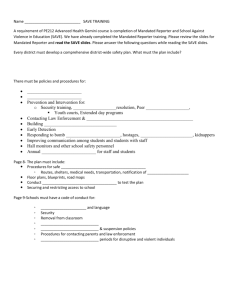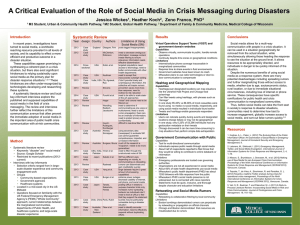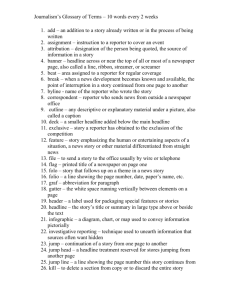Rumors and Reputation
advertisement
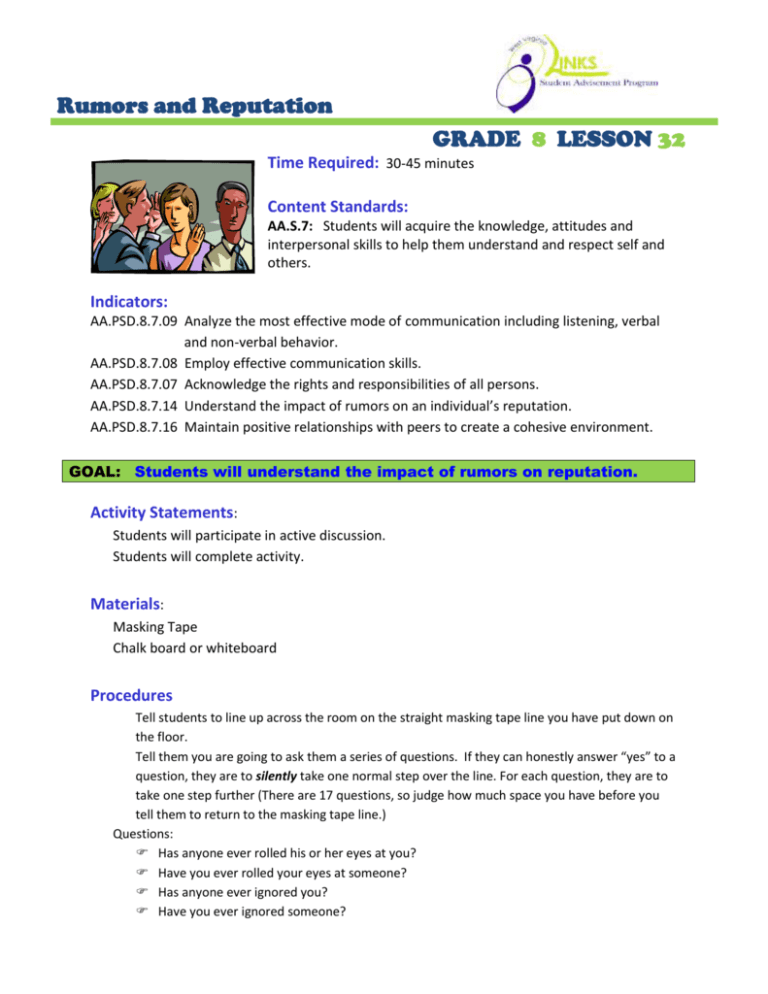
Rumors and Reputation GRADE 8 LESSON 32 Time Required: 30-45 minutes Content Standards: AA.S.7: Students will acquire the knowledge, attitudes and interpersonal skills to help them understand and respect self and others. Indicators: AA.PSD.8.7.09 Analyze the most effective mode of communication including listening, verbal and non-verbal behavior. AA.PSD.8.7.08 Employ effective communication skills. AA.PSD.8.7.07 Acknowledge the rights and responsibilities of all persons. AA.PSD.8.7.14 Understand the impact of rumors on an individual’s reputation. AA.PSD.8.7.16 Maintain positive relationships with peers to create a cohesive environment. GOAL: Students will understand the impact of rumors on reputation. Activity Statements: Students will participate in active discussion. Students will complete activity. Materials: Masking Tape Chalk board or whiteboard Procedures Tell students to line up across the room on the straight masking tape line you have put down on the floor. Tell them you are going to ask them a series of questions. If they can honestly answer “yes” to a question, they are to silently take one normal step over the line. For each question, they are to take one step further (There are 17 questions, so judge how much space you have before you tell them to return to the masking tape line.) Questions: Has anyone ever rolled his or her eyes at you? Have you ever rolled your eyes at someone? Has anyone ever ignored you? Have you ever ignored someone? Rumors and Reputation GRADE 8 LESSON 32 Have you ever been the subject of a rumor? Have you ever repeated a rumor? Has anyone ever been nice to you to your face then talked about you behind your back? Have you ever been excluded? Has anyone ever gossiped about you? Has anyone ever called you and tried to get you to say something negative about a person you did not know was already listening in to the conversation? Have you ever called someone on the telephone and tricked him/her into saying negative things about someone else who was secretly listening in on the conversation? Have you ever been cyber-bullied- computer, voice mail, or text? Have you ever cyber-bullied anyone? Discussion: Have the students return to their seats or sit in a circle where everyone can see each other’s faces. Ask: “How did you feel about this activity?” “What do you feel about the behaviors of gossiping? Rumors? Eye rolling?” “How does this behavior affect a person’s (victim’s) reputation?” Tell students they need to be aware of the following negative situations (relational aggression): Someone “directs” them to behave in a way that would hurt another person, but does not take responsibility for telling you what to do (the phone calls). Someone you thought you could trust uses information that you gave him/her against you. Someone is nice to your face, but gossips about you behind your back. Someone bumps, shoves, or in some other way picks on weaker people. Someone wants you to change. Someone makes you choose between friends. Ask students what they can do if they are a victim or witness these behaviors. (“I messages”, report to an adult, walk away, and answer so “so what”.) Remind students that there is a difference between tattling and reporting (telling). If someone is being hurt emotionally or physically, the incident must be reported to an adult. Reporting is being assertive and standing up for yourself and others and saying that you are not going to allow these hurtful behaviors to continue. Conclude by emphasizing the importance of treating each other with respect. They do not have to like everyone, but they should respect each other. If they cannot say something nice about someone, they should not say anything at all. Developed by: Myla Kreinik, Counselor, Hamilton Middle School (2009) Rumors and Reputation GRADE 8 LESSON 32 Alternative Lessons: Hit and Run- Choose three volunteers to be “reporters” of an event. Ask them to leave the room. Distribute copies of HIT AND RUN to the remainder of the class. Have someone read it out loud. Explain that you will call the “reporters” in one by one. When the first reporter comes in, you will read the description to the reporter. Then ask that person to repeat all he/she can remember to the second reporter. Call in the second reporter, and ask the first to repeat the news story detail by detail. When finished, bring in the third reporter and ask the second reporter to repeat the news story- detail by detail. The third reporter will face the group and repeat the news story as heard- detail by detail. As the students listen to the first reporter, they should place a single line under all of the information that person remembered. When they listen to the second reporter, they should circle those facts. When they listen to the third, they should put parentheses () around those details that are remembered. Be sure to give positive feedback to each reporter because these details are difficult to remember. Have the group give a “large round of applause” when finished. Discussions: How did the report change? Did important points get left out? How does this exercise relate to gossip and rumors? How do rumors affect one’s reputation? Additional Resources: “Guess What I Just Heard…” Ex. Pro. Susan Green. Sunburst Communications, 1999. Kirby, Becky. Classroom Guidance A to Z. MAR*CO PRODUCTS, INC., 2007. Lewis, Barbara. What Do You Stand For? For Teens- A Guide to Building Character. Free Spirit Publishing. Minneapolis, MN, 2005. Rumors and Lies, Gossip and Spies. Sunburst Visual Media, 2005. Rumor Mill, The: How Do You Know It’s True? Sunburst Visual Media, 2004. Extension Activities: Developed by: Myla Kreinik, Counselor, Hamilton Middle School (2009) Rumors and Reputation GRADE 8 LESSON 32 Have the students form groups of 4-5 members. The assignment is to write a children’s story about how rumors and gossip can hurt someone’s reputation. The guidelines are as follows: 1. Story is geared for 1st- 3rd grade; 2. Must have at least 3 illustrations; 3. No more than 25 pages; 4. Must have a cover; 5. 5. Story must be read aloud in class. Developed by: Myla Kreinik, Counselor, Hamilton Middle School (2009)
